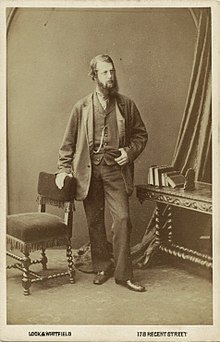George Sutherland-Leveson-Gower, 3rd Duke of Sutherland
George Granville William Sutherland-Leveson-Gower, 3rd Duke of Sutherland ( December 19, 1828 , † September 22, 1892 ) was one of the leading aristocrats of the United Kingdom in the Victorian era .
family
He was the eldest son and fifth child from the marriage of George Sutherland-Leveson-Gower, 2nd Duke of Sutherland (1786–1861) and his wife Elizabeth Gordon, 19th Countess of Sutherland (1765–1839). George Granville attended Eton College and King's College London .
In his first marriage he married Anne Hay-Mackenzie (1829-1888) in 1849, who was given the title Countess of Cromartie in 1861 in his own right . They had five children:
- George Granville Sutherland-Leveson-Gower, Earl Gower (born July 27, 1850, † July 5, 1858);
- Cromartie Sutherland-Leveson-Gower, 4th Duke of Sutherland (born July 20, 1851, † June 27, 1913);
- Francis Mackenzie, 2nd Earl of Cromartie (born August 3, 1852, † November 24, 1893);
- Lady Florence Sutherland Leveson-Gower († October 10, 1881), ⚭ 1876 Henry Chaplin, 1st Viscount Chaplin ;
- Lady Alexandra Sutherland Leveson-Gower († April 16, 1891), unmarried.
After the death of his first wife, he married - scandalously because only four months had passed after the death of his first wife and she had previously lived with the Duke in Tampa , Florida for two months - Mary Caroline Blair, née Mitchell, widow of the captain Arthur Kindersley Blair, 71st Highland Light Infantry Regiment, daughter of Rev Richard Mitchell. Her first husband, dependent on the Duke, is said to have died - according to newspaper reports - as a result of a hunting accident caused by the Duke.
When the duke died, the "Duchess Blair" allegedly withheld documents in order to influence the inheritance in their favor, which earned them six weeks in prison. With the family of the Dukes it finally came to a settlement which enabled her, Carbisdale Castle to build and an annual income of 100,000 pounds sterling to relate.
Public work
George Granville was an MP for the Sutherland constituency of the House of Commons from 1852 to 1861 . When he inherited his seat in the House of Lords after his father's death in 1861 , he had to give up his mandate in the House of Commons.
The Duke was an avid hobby railroader who - he was one of the richest men in Great Britain of his time - not only financed the Duke of Sutherland's Railway , now part of the Far North Line , and also made significant investments in other railway companies, but also made a private contribution a locomotive, the Dunrobin , added and drove it himself, as well as a saloon car to take his guests for walks. This also included Queen Victoria . For the opening of his own railway, the Duke of Sutherland's Railway , the then Prince of Wales Prince Edward and his wife Alexandra had been invited and come.
literature
- James Balfour Paul: The Scots Peerage. Volume 3, David Douglas, Edinburgh 911, p. 362 ff. ( Archive.org )
- David McConell: Rails to Wick & Thurso . Dornoch Press, Dornoch, undated [before 1990], ISBN 0-9513358-7-1 .
Web links
- The Leveson-Gower Family
- George Granville William Sutherland-Leveson-Gower, 3rd Duke of Sutherland on thepeerage.com , accessed September 18, 2016.
- His second duchess Mary Caroline
Individual evidence
- ↑ paperspast.natlib.govt.nz .
- ^ Scots Peerage , p. 364.
- ↑ The successor to this saloon car, bought by his son and successor Cromartie Sutherland-Leveson-Gower, 4th Duke of Sutherland, is shown today in the collection of the National Railway Museum in York .
| predecessor | Office | successor |
|---|---|---|
| George Sutherland-Leveson-Gower |
Duke of Sutherland 1861-1892 |
Cromartie Sutherland-Leveson-Gower |
| personal data | |
|---|---|
| SURNAME | Sutherland-Leveson-Gower, George, 3rd Duke of Sutherland |
| ALTERNATIVE NAMES | Sutherland, George Granville William Sutherland-Leveson-Gower 3rd Duke of |
| BRIEF DESCRIPTION | British nobleman and politician, member of the House of Commons |
| DATE OF BIRTH | December 19, 1828 |
| DATE OF DEATH | September 22, 1892 |

